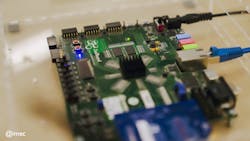Wireless Time-Sensitive Networks: When Every Microsecond Counts
Download this article in PDF format.
What you’ll learn:
- What's the role of TSNs in supporting mission-critical industrial applications?
- Which specifications should a (wireless) TSN adhere to?
- Are wireless technologies up to the challenge?
- If so, should we opt for cellular (4G or 5G) technologies or Wi-Fi?
Efficient factories build on a timely exchange of data, but not every piece of information should be treated equally. Emails, for instance, can typically be delivered with an acceptable delay. Other applications, however, strongly depend on a prompt transfer of the underlying (sensor) data. Think of autonomous-system applications such as drones, cobots, automated guided vehicles, or closed-loop control systems where every (micro)second is vital. This is where time-sensitive networks (TSNs) come in.
Since the 1980s, Ethernet has been the default technology option for exchanging factories’ time-critical data. While they are robust, Ethernet-based TSNs also have a huge drawback: With cables running everywhere, rearranging a factory’s production floor becomes quite a challenge. That’s why the manufacturing industry has been calling for the installation of wireless TSNs, unhindered by the roll-out of cables. But are wireless communication technologies capable of meeting TSNs’ stringent requirements?
When Every Microsecond Counts
So far, the telecom industry has focused on increasing networks’ speed and capacity as subscriber demands escalate for ever-faster internet surfing and downloading large (video) files. Therefore, for most industrial applications, a lack of bandwidth has long since ceased to be a problem as well.
All the while, though, considerably less attention has been paid to guaranteeing low latencies and foreseeing the right level of redundancy. Yet, those guarantees are crucial in support of mission-critical applications. Think of Industry 4.0 applications such as closed-loop control systems, or the deployment of drones, cobots, and automated guided vehicles. For such use cases, a low latency, a guaranteed quality of service (QoS), and accurate time synchronization are essential.
An accurate time synchronization between the various devices in a smart, connected factory is becoming increasingly important. Closed-loop control systems, for instance, strongly depend on quick and accurate scheduling of any communication between the underlying sensors and actuators. Other examples of time-sensitive applications include distributed speaker systems and advanced augmented-reality (AR), virtual reality (VR), and video applications. In the case of audio and video apps, a poor synchronization is even audible and visible, and utmost disturbing.
Un-wiring the Factory
Since the 1980s, the exchange of (time-sensitive) data in factories has mainly relied on robust Ethernet technology. Hence, it’s the Ethernet community that took a clear lead in supporting the roll-out of TSNs by introducing a TSN-based Ethernet specification (IEEE 802.1Qbv) that meets three critical characteristics of wired time-sensitive networks:
- End-to-end signal delay of 2 ms (over seven hops) for business-critical traffic
- Time-synchronization accuracy of less than 1 µs (up to a few nanoseconds in specific scenarios)
- 99.99999% reliability
Still, the use of a wired network comes with significant disadvantages. For example, every time a production floor is rearranged, all cables need to be redrawn as well. Of course, this requires immense planning and preparation, comes with a huge cost, and makes on-the-fly optimization impossible. Moreover, with the installation of every new machine—and each individual sensor—even more cables are drawn, and for the sake of redundancy, cables are often installed twice.
Thus, the call for wireless TSNs grows louder and louder. Wireless networks, however, are much more susceptible to network failures, bandwidth limitations, and blocked signals than their wired counterparts. Admittedly, mobile technologies have been making significant progress in providing stability and reliability, but there’s still much work to be done, especially when time synchronization is concerned.
So, where do we stand today? Are wireless TSNs a realistic option to enable tomorrow’s smart, connected factories? If so, should we opt for cellular (4G or 5G) technologies, or Wi-Fi?
5G vs. Wi-Fi
When it comes to rolling out wireless TSNs, the 5G community has been betting on the recently specified 5G ultra-reliable low-latency communication (URLLC) feature. With the introduction of 5G URLLC, the community aims to get as close as possible to the performance specs of Ethernet-based TSNs. Concrete targets are a signal delay of no more than 1 µs, a time-synchronization accuracy of no more than 1 ms, and a 99.999% reliability. In those respects, 5G undeniably holds a significant advantage.
Yet, Wi-Fi has its advantages, too. On the one hand, a Wi-Fi network is easier to install, faster, and less costly than a cellular one. And there’s the compatibility factor: Ethernet (IEEE 802.3) and Wi-Fi (IEEE 802.11) belong to the same family of standards. That makes Wi-Fi the most obvious technology option for companies wanting to transform their wired (Ethernet) network into a wireless alternative.
At the radio level, 5G and Wi-Fi are quite similar and accommodate roughly the same bit rates. The big difference is that 5G uses licensed spectrum that’s exclusively allocated to a telecom operator, while Wi-Fi operates in the free spectrum and is therefore bound by more stringent “courtesy” rules.
When a Wi-Fi device wants to use the free spectrum, it first must verify that no other devices are using that same radio band. As a result, each time a wireless package is transmitted, an unpredictable (shorter or longer) pause must be inserted, which could increase latency. In this regard, because 5G is more strictly regulated, it has a clear advantage.
However, that may change, as some countries already allow purchasing local spectrum for the deployment of a private 5G network. Because the radio spectrum is technology-neutral, though, the same principle could be applied to set up a Wi-Fi network that would no longer be bound by those more stringent “courtesy” rules.
Ultimately, we expect 5G and Wi-Fi to coexist, even when it comes to supporting time-sensitive networks. Due to their wider range, cellular technologies such as 5G will come with a slight advantage for outdoor TSN deployments; and Wi-Fi is a priori suited for indoor operations. However, everything hinges on the technologies’ support for even more accurate time synchronization.
A World’s First: The “openwifi” Chip
Any Wi-Fi-based, time-sensitive network needs to schedule its communication in dedicated time slots. As a result, accurate time synchronization between the various connected devices is crucial, because any synchronization inaccuracies must be absorbed by buffers—the so-called “guard time.” That, in turn, comes at the expense of efficiency. After all, it’s best to schedule useful time slots as closely together as possible and minimize buffers in which no communication is possible.
One of Wi-Fi’s challenges is that, today, it only allows for a time-synchronization accuracy of a few tens of milliseconds, all while a typical Wi-Fi packet is only about a hundred microseconds long. It’s not terribly efficient if you must insert a buffer of, say, 30 ms between each of those short packets.
With the advent of imec’s openwifi custom-made radio chip, designers now have full control over the hardware in which the time-synchronization features are embedded (Fig. 1). This feature isn’t typically available when one is experimenting with commercial Wi-Fi chips.
imec’s openwifi makes possible a world’s first—improving Wi-Fi’s time-synchronization accuracy by a factor of 10,000 compared to today’s commercial state of the art, down to the level of 1 µs. That’s considerably better than the ambitions of the international Wi-Fi Alliance, which had set a target of 5.5 µs.
Open-Source Software Speeds Innovation
To accelerate research into wireless TSNs as well as its commercialization, imec has chosen to make some of openwifi’s basic functionality available as open-source software. We hope that will give application developers and chip manufacturers from all over the world the opportunity to experiment with openwifi. Those not having the proper infrastructure can even use our remote test facilities (Fig. 2).
Openwifi is popular on Github, the largest open-source software development platform in the world. There, it’s ranked in the top four of the most valued FPGA contributions and has been downloaded over 200 times.
It’s our intention to give industrial partners a unique opportunity to test their applications on top of openwifi and evaluate whether those applications are compatible with tomorrow's time-sensitive Wi-Fi solutions. For example, Televic, a Belgian provider of specialized communication solutions, has shown interest in openwifi to test one of its low-latency audio streaming systems.
imec allows companies to test a number of Wi-Fi-based TSN features, independent of vendor-specific implementations and chipsets (which aren’t yet commercially available anyway). That should provide them with a significant competitive advantage.
We also can enrich Wi-Fi packets with real-time network and end-to-end monitoring information. As packets travel through the network, that allows us to determine the performance of a given Wi-Fi network. In doing so, we measure what happens with a Wi-Fi packet without having to send extra traffic through the network, making it much easier to pinpoint the sources of issues. Moreover, one could also use this input for network reconfigurations, or to check whether the agreed-upon QoS is being met. This technique has been used in data centers for some time, but not until now has it been implemented in a wireless network.
First Steps Taken—More to Come
So, when will factories be able to deploy wireless TSNs? We assert that it’s still too early in the development process. We will gradually see TSN-based features appear in wireless networks in coming years, but that will happen step by step. First comes development of commercial chips that support those features; then applications can follow. Meanwhile, we watch with interest how 5G and Wi-Fi will continue to tackle the need for wireless TSNs. It’s already evident that both offer a clear added value in supporting time-critical applications.
Openwifi is one outcome of the ORCA project supported by the European Horizon2020 program.
Openwifi Resources
- Interested in experimenting with openwifi? An openwifi evaluation kit is currently under development, featuring a full TSN Wi-Fi stack and the necessary support. The evaluation kit will significantly lower the threshold for companies to evaluate the benefits brought by time-sensitive Wi-Fi. More info via [email protected].
- The openwifi Linux driver and software can be downloaded from https://github.com/open-sdr/openwifi (Linux mac80211 compatible full-stack IEEE802.11/Wi-Fi FPGA design based on SDR).
- Thanks to the (remote) IDLab test infrastructure of imec, the University of Antwerp and Ghent University, all possible wireless technologies can be put to the test—from Wi-Fi to 4G, 5G, and even future 6G radio architectures based on distributed massive MIMO. More info and technical documentation via https://idlab.technology/infrastructure/.
About the Author
Ingrid Moerman
Professor, Ghent University; Staff member, IDLab
Ingrid Moerman is a professor at Ghent University and staff member at IDLab, an imec research group at Ghent University and the University of Antwerp (Belgium). Moerman heads a research team of more than 30 focusing on mobile and wireless networking. Her research interests include collaborative and cooperative networks; intelligent cognitive radio networks; real-time, software-defined radio; flexible hardware/software architectures for radio/network control and management; high-density wireless access networks; and more.


